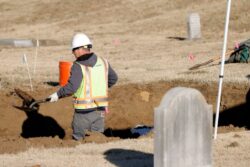A total of 21 unmarked coffins were discovered at a location believed to be used as a mass burial ground after the Tulsa race massacre (Picture: AP)
An excavation into a suspected mass burial site for victims of the 1921 Tulsa race massacre has unearthed another 21 unmarked graves.
The search for victims of the brutal riot 100 years ago has turned up a series of unmarked coffins that investigators say might hold remains of victims of one of the worst incidents of anti-black violence in American history.
Investigators working for the city of Tulsa, Oklahoma’s 1921 Graves project announced the discovered 17 adult graves over the weekend of October 28 and 29. Another six coffins – four adult, and two child-sized – were discovered the following Tuesday, November 1.
To view this video please enable JavaScript, and consider upgrading to a web
browser that
supports HTML5
video
Kary Stackelbeck, Oklahoma’s State Archaeologist, said her team obtained DNA samples and hopes they will be able to identify some of the individuals buried at the site.
‘We’re trying to do every step of this process as respectfully as possible,’ Stackelbeck said in a video message.
She also noted they were not planning to exhume any of the infants or children found at the site.
The Tulsa race massacre happened over 100 years ago in the city’s Greenwood neighborhood. Greenwood was founded as a freedom colony of former slaves after the Civil War.
Crews work on an excavation at Oaklawn Cemetery searching for victims of the 1921 Tulsa Race Massacre (Picture: AP)
Pastor Rodney Goss with Morning Star Baptist Church leads a prayer during a reburial ceremony at Oaklawn Cemetery during an excavation while searching for bodies from the 1921 Tulsa Race Massacre (Picture: AP)
Over the course of two days, a violent white mob targeted one of the most prosperous black communities, which was home to a thriving business district known as Black Wall Street.
The mob burned down about 40 blocks of black-owned businesses and homes, leaving about 10,000 people homeless overnight.
Historians estimate the massacre killed up to 300 people, but many were buried in unmarked graves that are still being discovered today.
Forensic anthropologists carry excavated human remains to a lab at Oaklawn Cemetery while searching for victims of the 1921 Tulsa Race Massacre (Picture: AP)
Crews work on an excavation at Oaklawn Cemetery searching for victims of the 1921 Tulsa Race Massacre (Picture: AP)
A group prays during a small ceremony as remains from a mass grave are re-interred at Oaklawn Cemetery on July 30, 2021 (Picture: AP)
The current search for victims began in 2020, when ground-penetrating radar sweeps identified areas with possible graves.
Excavations in 2021 unearthed 19 unidentified graves, but the researchers were unable to gather enough DNA to determine their identities.
Only 3 survivors are still alive today, and all of them are over 100 years old. The survivors and their descendants filed a lawsuit in 2003, hoping to finally receive reparations for the tragedy.
Got a story? Get in touch with our news team by emailing us at [email protected]. Or you can submit your videos and pictures here.
For more stories like this, check our news page.
Follow Metro.co.uk on Twitter and Facebook for the latest news updates. You can now also get Metro.co.uk articles sent straight to your device. Sign up for our daily push alerts here.
Archaeologists hope to obtain DNA samples to positively identify the victims.





